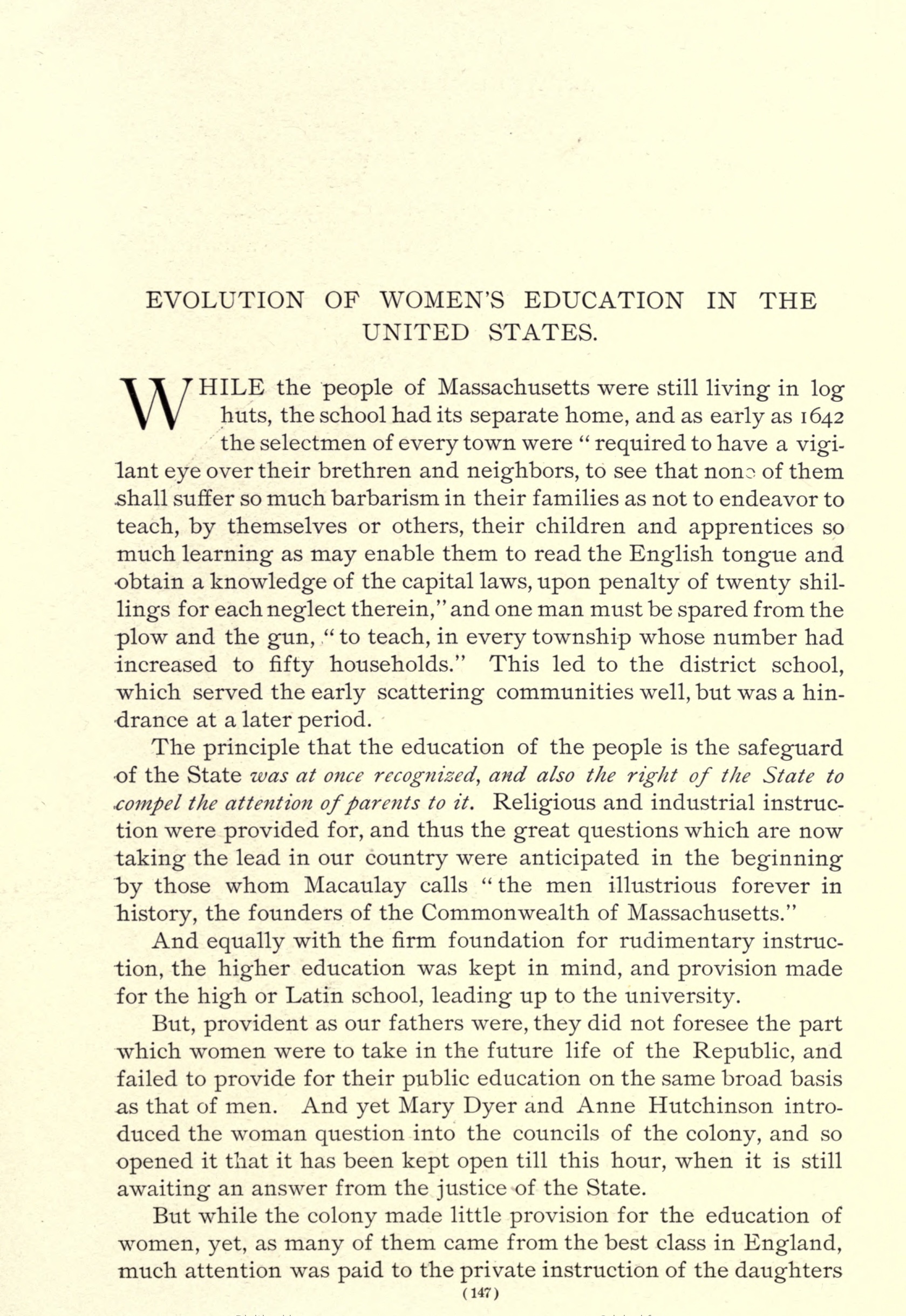
EVOLUTION OF WOMEN'S EDUCATION IN THE UNITED STATES.
WHILE the people of Massachusetts were still living in log huts, the school had its separate home, and as early as 1642 the selectmen of every town were "required to have a vigilant eye over their brethren and neighbors, to see that none of them shall suffer so much barbarism in their families as not to endeavor to teach, by themselves or others, their children and apprentices so much learning as may enable them to read the English tongue and obtain a knowledge of the capital laws, upon penalty of twenty shillings for each neglect therein," and one man must be spared from the plow and the gun, "to teach, in every township whose number had increased to fifty households." This led to the district school, which served the early scattering communities well, but was a hindrance at a later period.
The principle that the education of the people is the safeguard of the State was at once recognized, and also the right of the State to compel the attention of parents to it. Religious and industrial instruction were provided for, and thus the great questions which are now taking the lead in our country were anticipated in the beginning by those whom Macaulay calls "the men illustrious forever in history, the founders of the Commonwealth of Massachusetts."
And equally with the firm foundation for rudimentary instruction, the higher education was kept in mind, and provision made for the high or Latin school, leading up to the university.
But, provident as our fathers were, they did not foresee the part which women were to take in the future life of the Republic, and failed to provide for their public education on the same broad basis as that of men. And yet Mary Dyer and Anne Hutchinson introduced the woman question into the councils of the colony, and so opened it that it has been kept open till this hour, when it is still awaiting an answer from the justice of the State.
But while the colony made little provision for the education of women, yet, as many of them came from the best class in England, much attention was paid to the private instruction of the daughters
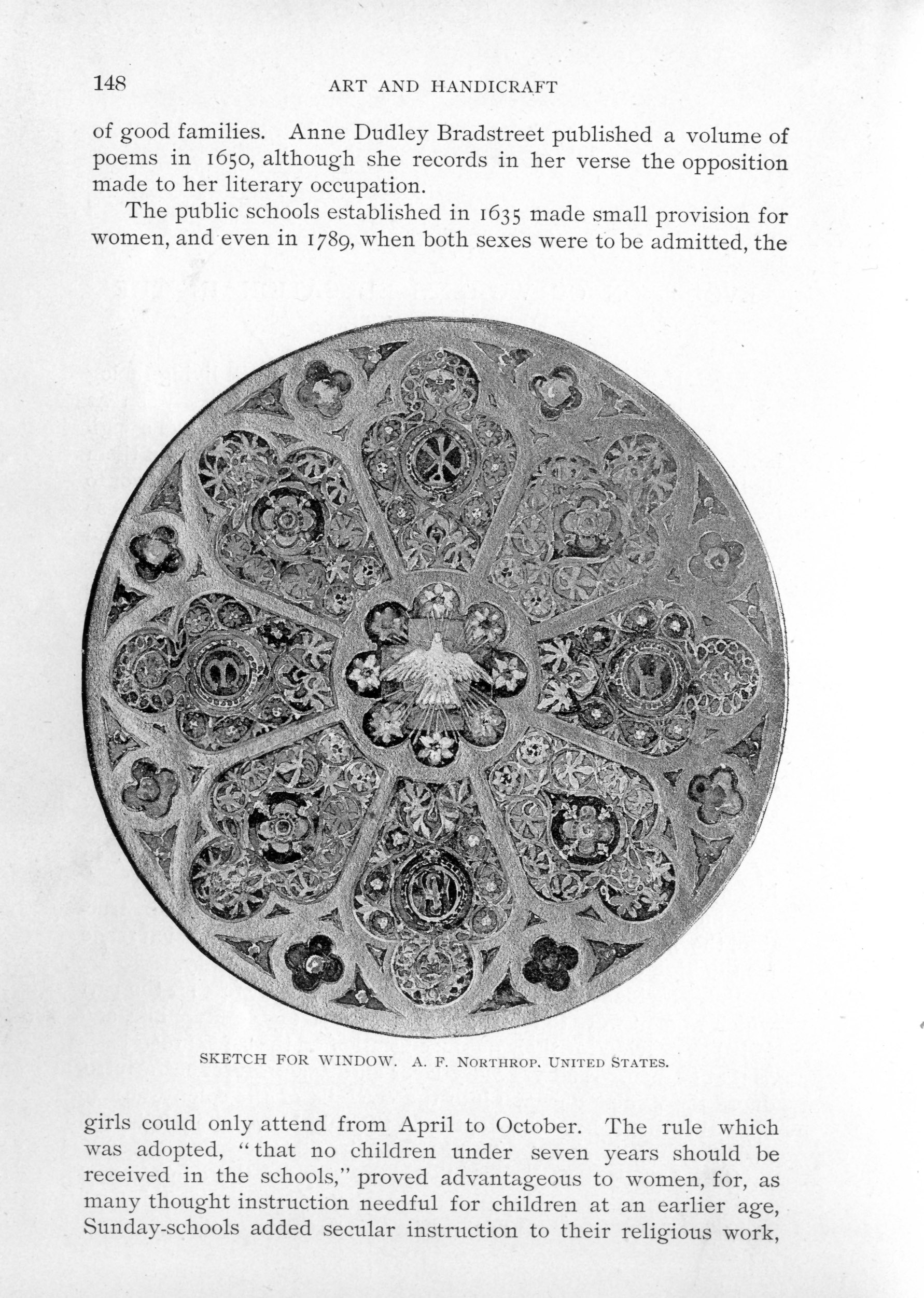
SKETCH FOR WINDOW.
A. F. NORTHROP.
UNITED STATES.
of good families. Anne Dudley Bradstreet published a volume of poems in 1650, although she records in her verse the opposition made to her literary occupation.
The public schools established in 1635 made small provision for women, and even in 1789, when both sexes were to be admitted, the girls could only attend from April to October. The rule which was adopted, "that no children under seven years should be received in the schools," proved advantageous to women, for, as many thought instruction needful for children at an earlier age, Sunday-schools added secular instruction to their religious work,
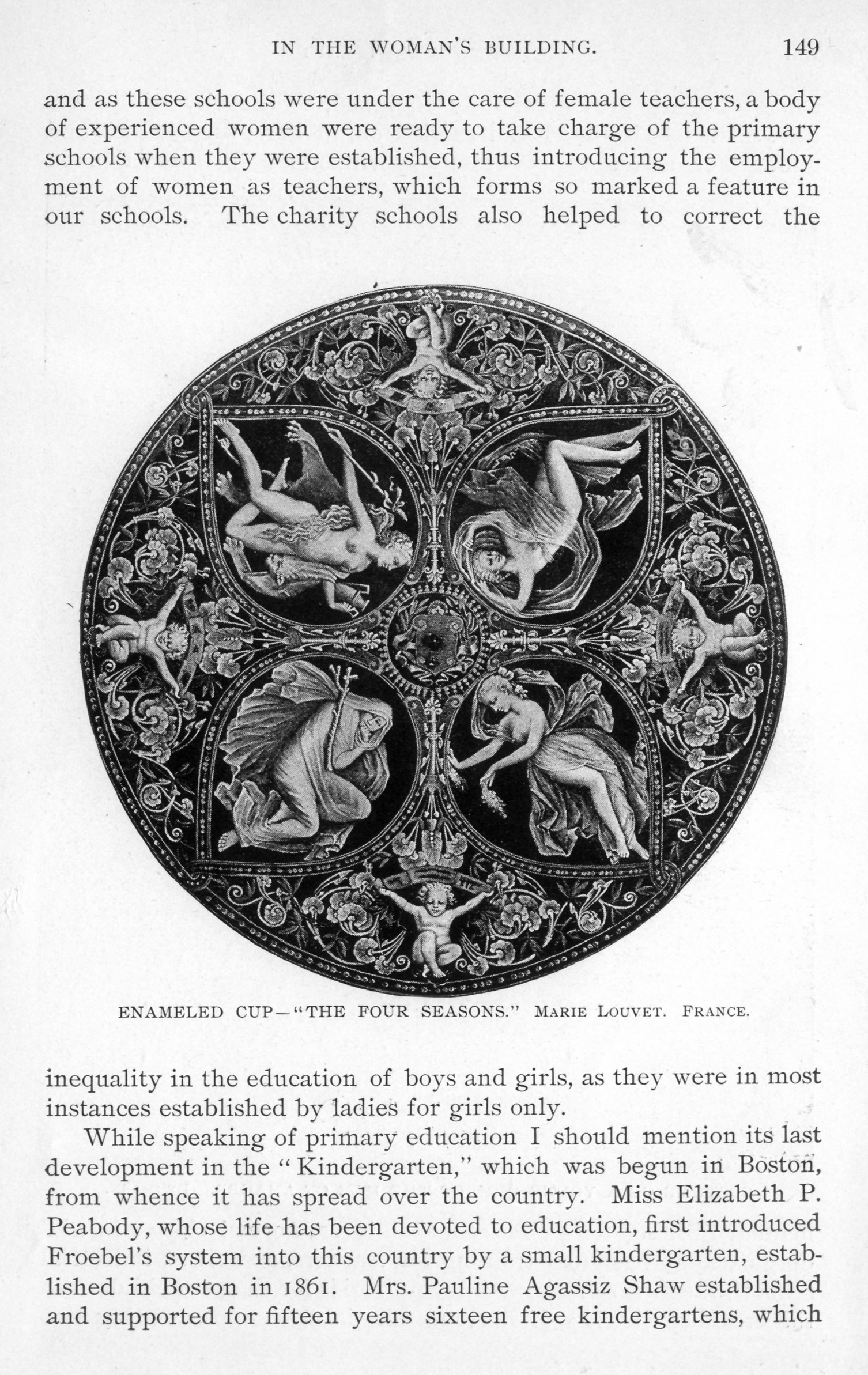
ENAMELED CUP—
"THE FOUR SEASONS."
MARIE LOUVET.
FRANCE.
and as these schools were under the care of female teachers, a body of experienced women were ready to take charge of the primary schools when they were established, thus introducing the employment of women as teachers, which forms so marked a feature in our schools. The charity schools also helped to correct the inequality in the education of boys and girls, as they were in most instances established by ladies for girls only.
While speaking of primary education I should mention its last development in the "Kindergarten," which was begun in Boston, from whence it has spread over the country. Miss Elizabeth P. Peabody, whose life has been devoted to education, first introduced Froebel's system into this country by a small kindergarten, established in Boston in 1861. Mrs. Pauline Agassiz Shaw established and supported for fifteen years sixteen free kindergartens, which
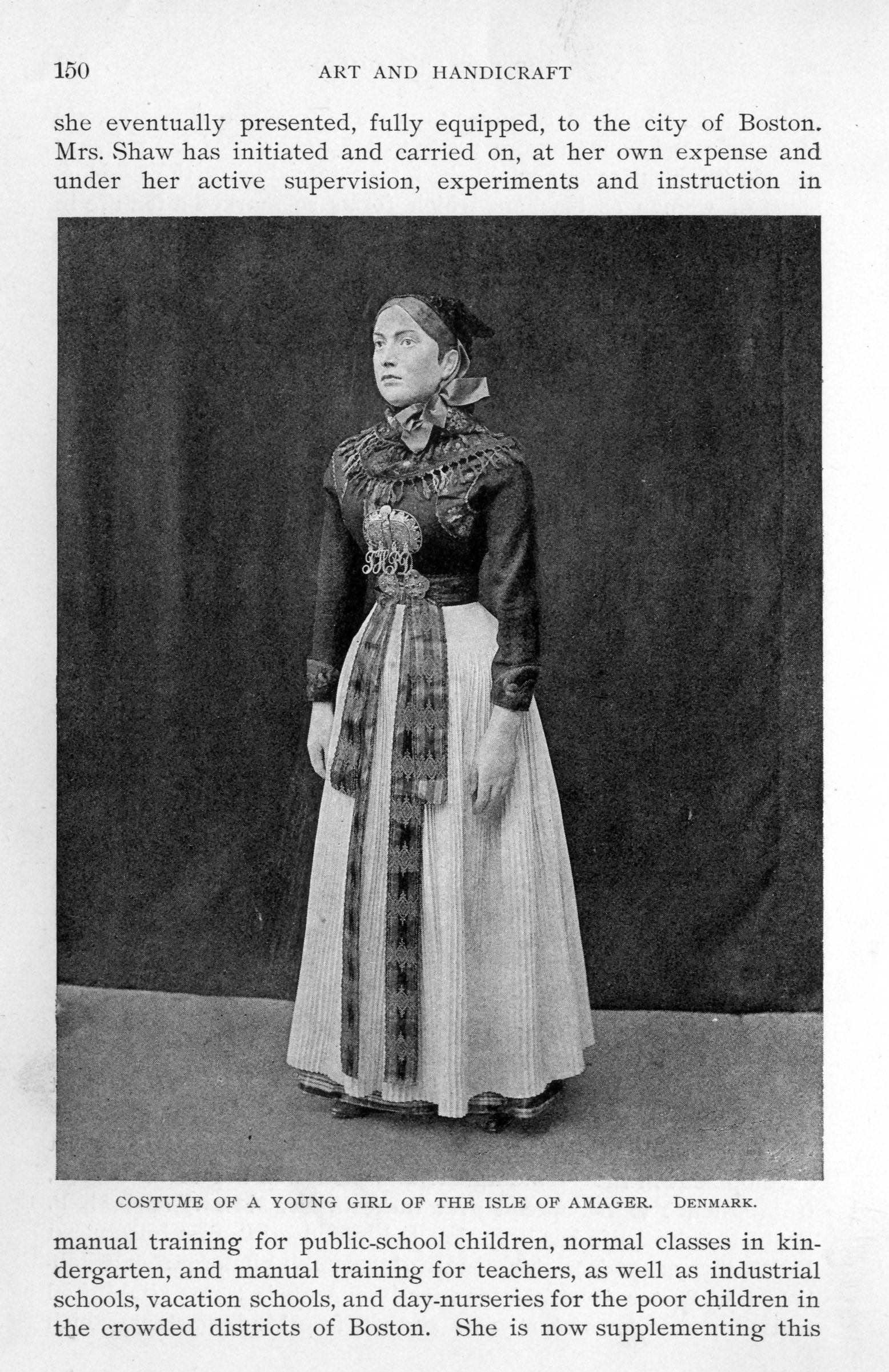
COSTUME OF A YOUNG GIRL OF THE ISLE OF AMAGER. DENMARK.
she eventually presented, fully equipped, to the city of Boston. Mrs. Shaw has initiated and carried on, at her own expense and under her active supervision, experiments and instruction in manual training for public-school children, normal classes in kindergarten, and manual training for teachers, as well as industrial schools, vacation schools, and day-nurseries for the poor children in the crowded districts of Boston. She is now supplementing this
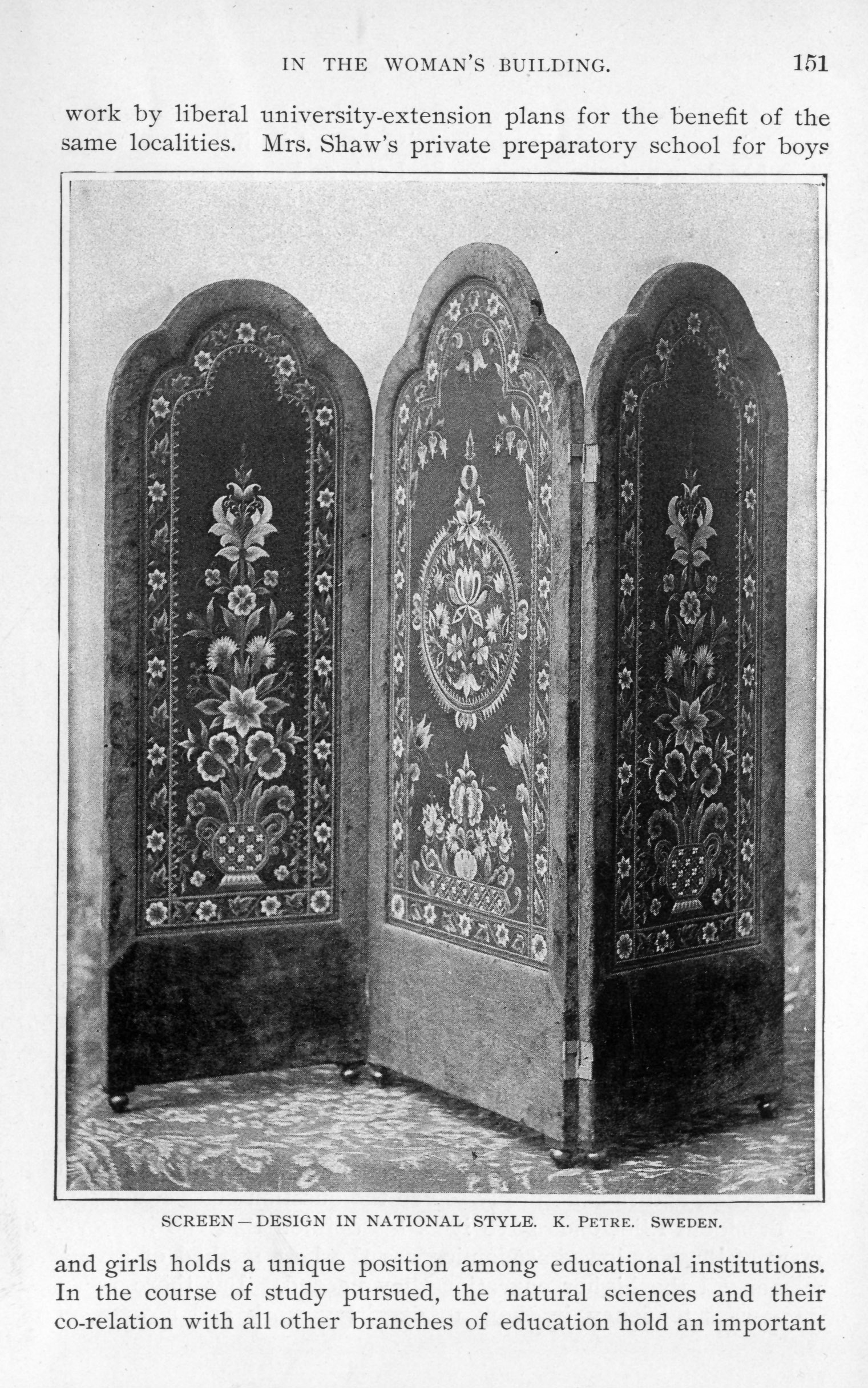
SCREEN—DESIGN IN NATIONAL STYLE. K. PETRE. SWEDEN.
work by liberal university extension plans for the benefit of the same localities. Mrs. Shaw's private preparatory school for boys and girls holds a unique position among educational institutions. In the course of study pursued, the natural sciences and their co-relation with all other branches of education hold an important
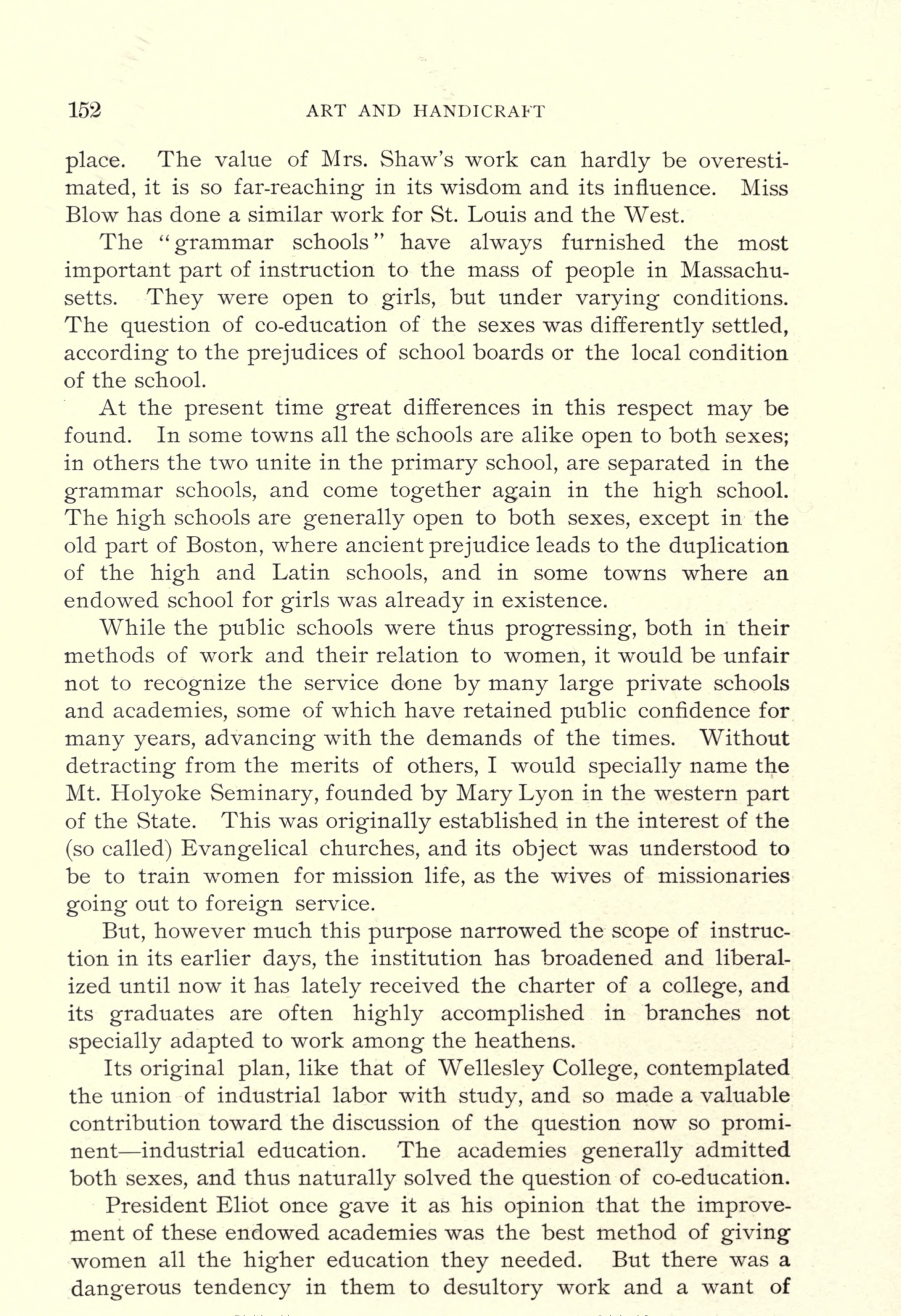
place. The value of Mrs. Shaw's work can hardly be overestimated, it is so far-reaching in its wisdom and its influence. Miss Blow has done a similar work for St. Louis and the West.
The "grammar schools" have always furnished the most important part of instruction to the mass of people in Massachusetts. They were open to girls, but under varying conditions. The question of co-education of the sexes was differently settled, according to the prejudices of school boards or the local condition of the school.
At the present time great differences in this respect may be found. In some towns all the schools are alike open to both sexes; in others the two unite in the primary school, are separated in the grammar schools, and come together again in the high school. The high schools are generally open to both sexes, except in the old part of Boston, where ancient prejudice leads to the duplication of the high and Latin schools, and in some towns where an endowed school for girls w as already in existence.
While the public schools were thus progressing, both in their methods of work and their relation to women, it would be unfair not to recognize the service done by many large private schools and academies, some of which have retained public confidence for many years, advancing with the demands of the times. Without detracting from the merits of others, I would specially name the Mt. Holyoke Seminary, founded by Mary Lyon in the western part of the State. This was originally established in the interest of the (so called) Evangelical churches, and its object was understood to be to train women for mission life, as the wives of missionaries going out to foreign service.
But, however much this purpose narrowed the scope of instruction in its earlier days, the institution has broadened and liberalized until now it has lately received the charter of a college, and its graduates are often highly accomplished in branches not specially adapted to work among the heathens.
Its original plan, like that of Wellesley College, contemplated the union of industrial labor with study, and so made a valuable contribution toward the discussion of the question now so prominent—industrial education. The academies generally admitted both sexes, and thus naturally solved the question of co-education.
President Eliot once gave it as his opinion that the improvement of these endowed academies was the best method of giving women all the higher education they needed. But there was a dangerous tendency in them to desultory work and a want of
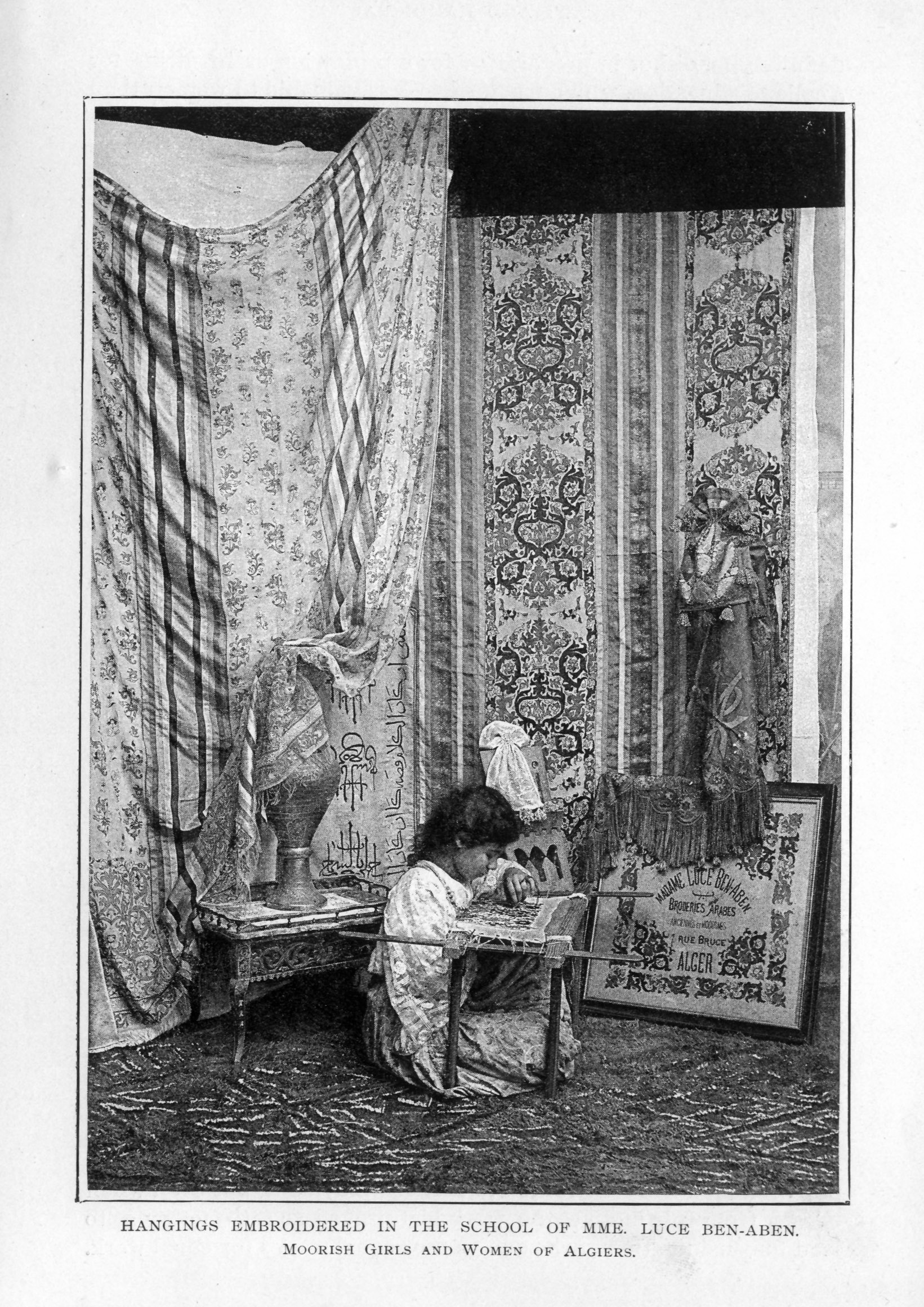
HANGINGS EMBROIDERED IN THE SCHOOL OF MME. LUCE BEN-ABEN.
MOORISH GIRLS AND WOMEN OF ALGIERS.
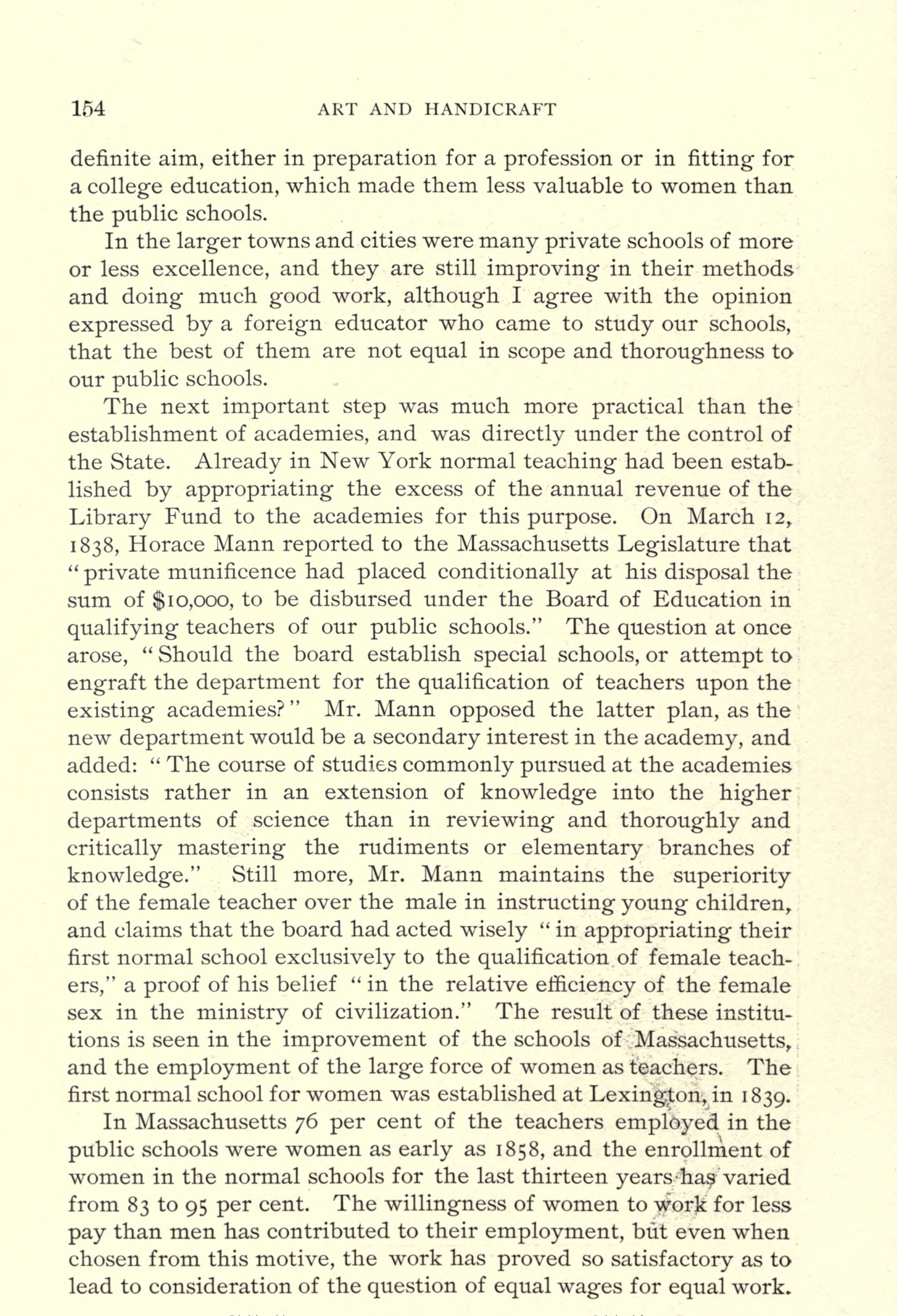
definite aim, either in preparation for a profession or in fitting for a college education, which made them less valuable to women than the public schools.
In the larger towns and cities were many private schools of more or less excellence, and they are still improving in their methods and doing much good work, although I agree with the opinion expressed by a foreign educator who came to study our schools, that the best of them are not equal in scope and thoroughness to our public schools.
The next important step was much more practical than the establishment of academies, and was directly under the control of the State. Already in New York normal teaching had been established by appropriating the excess of the annual revenue of the Library Fund to the academies for this purpose. On March 12, 1838, Horace Mann reported to the Massachusetts Legislature that "private munificence had placed conditionally at his disposal the sum of $10,000, to be disbursed under the Board of Education in qualifying teachers of our public schools." The question at once arose, "Should the board establish special schools, or attempt to engraft the department for the qualification of teachers upon the existing academies?" Mr. Mann opposed the latter plan, as the new department would be a secondary interest in the academy, and added: "The course of studies commonly pursued at the academies consists rather in an extension of knowledge into the higher departments of science than in reviewing and thoroughly and critically mastering the rudiments or elementary branches of knowledge." Still more, Mr. Mann maintains the superiority of the female teacher over the male in instructing young children, and claims that the board had acted wisely "in appropriating their first normal school exclusively to the qualification of female teachers," a proof of his belief "in the relative efficiency of the female sex in the ministry of civilization." The result of these institutions is seen in the improvement of the schools of Massachusetts, and the employment of the large force of women as teachers. The first normal school for women was established at Lexington, in 1839.
In Massachusetts 76 per cent of the teachers employed in the public schools were women as early as 1858, and the enrollment of women in the normal schools for the last thirteen years has varied from 83 to 95 per cent. The willingness of women to work for less pay than men has contributed to their employment, but even when chosen from this motive, the work has proved so satisfactory as to lead to consideration of the question of equal wages for equal work.
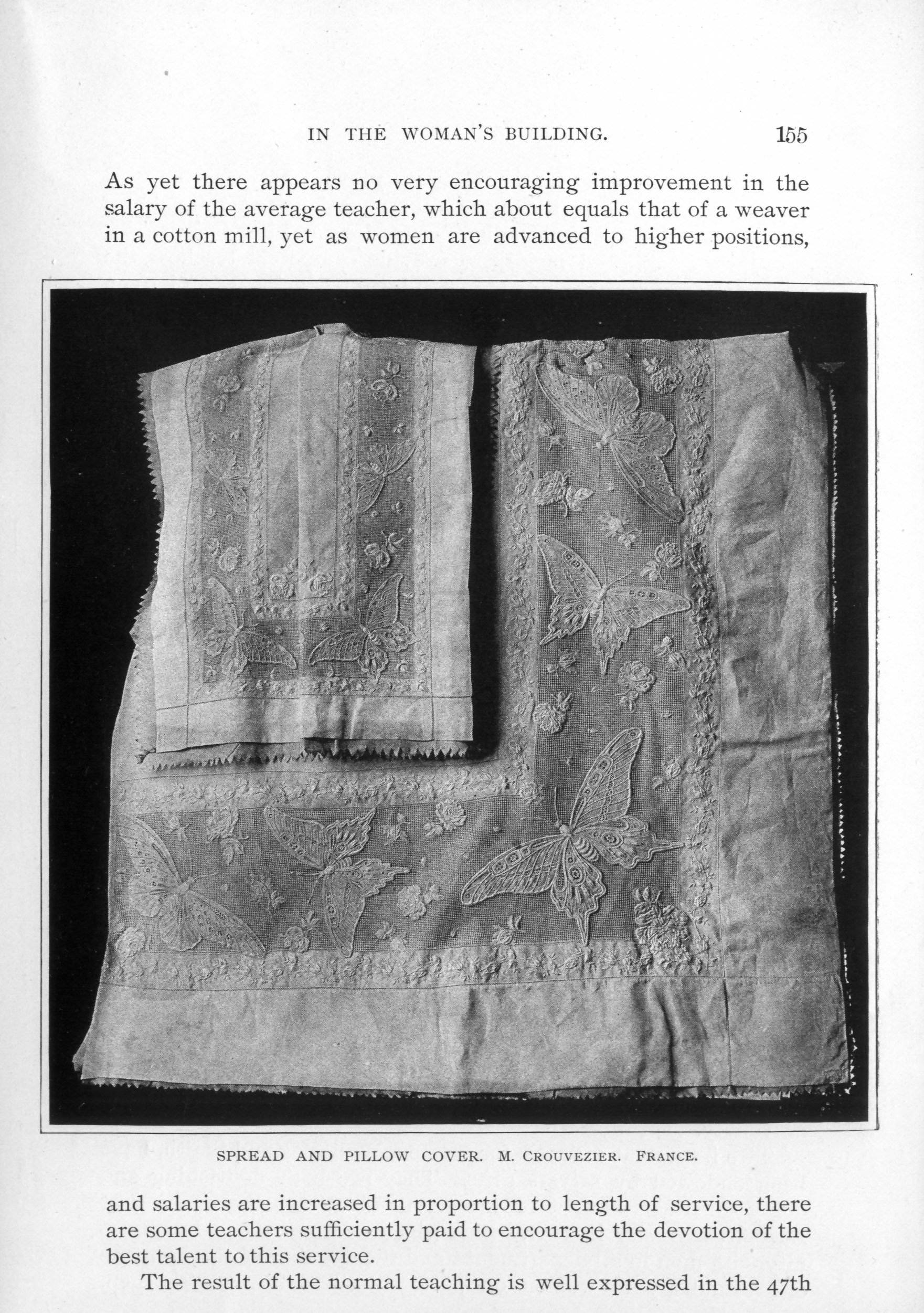
SPREAD AND PILLOW COVER.
M. CROUVEZIER.
FRANCE.
As yet there appears no very encouraging improvement in the salary of the average teacher, which about equals that of a weaver in a cotton mill, yet as women are advanced to higher positions, and salaries are increased in proportion to length of service, there are some teachers sufficiently paid to encourage the devotion of the best talent to this service.
The result of the normal teaching is well expressed in the 47th
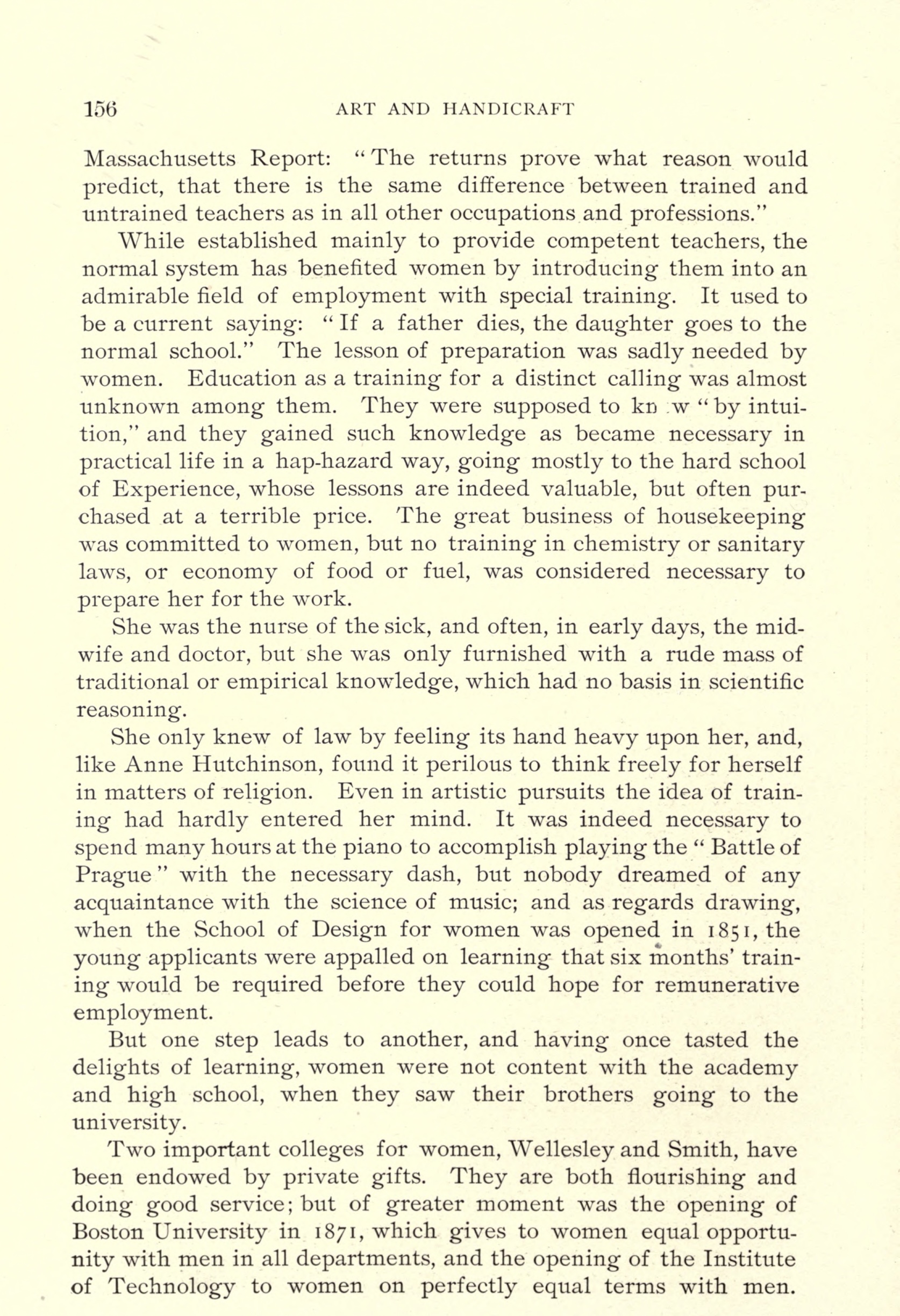
Massachusetts Report: "The returns prove what reason would predict, that there is the same difference between trained and untrained teachers as in all other occupations and professions."
While established mainly to provide competent teachers, the normal system has benefited women by introducing them into an admirable field of employment with special training. It used to be a current saying: "If a father dies, the daughter goes to the normal school." The lesson of preparation was sadly needed by women. Education as a training for a distinct calling was almost unknown among them. They were supposed to know "by intuition," and they gained such knowledge as became necessary in practical life in a hap-hazard way, going mostly to the hard school of Experience, whose lessons are indeed valuable, but often purchased at a terrible price. The great business of housekeeping was committed to women, but no training in chemistry or sanitary laws, or economy of food or fuel, was considered necessary to prepare her for the work.
She was the nurse of the sick, and often, in early days, the midwife and doctor, but she was only furnished with a rude mass of traditional or empirical knowledge, which had no basis in scientific reasoning.
She only knew of law by feeling its hand heavy upon her, and, like Anne Hutchinson, found it perilous to think freely for herself in matters of religion. Even in artistic pursuits the idea of training had hardly entered her mind. It was indeed necessary to spend many hours at the piano to accomplish playing the "Battle of Prague" with the necessary dash, but nobody dreamed of any acquaintance with the science of music; and as regards drawing, when the School of Design for women was opened in 1851, the young applicants were appalled on learning that six months' training would be required before they could hope for remunerative employment.
But one step leads to another, and having once tasted the delights of learning, women were not content with the academy and high school, when they saw their brothers going to the university.
Two important colleges for women, Wellesley and Smith, have been endowed by private gifts. They are both flourishing and doing good service; but of greater moment was the opening of Boston University in 1871, which gives to women equal opportunity with men in all departments, and the opening of the Institute of Technology to women on perfectly equal terms with men.
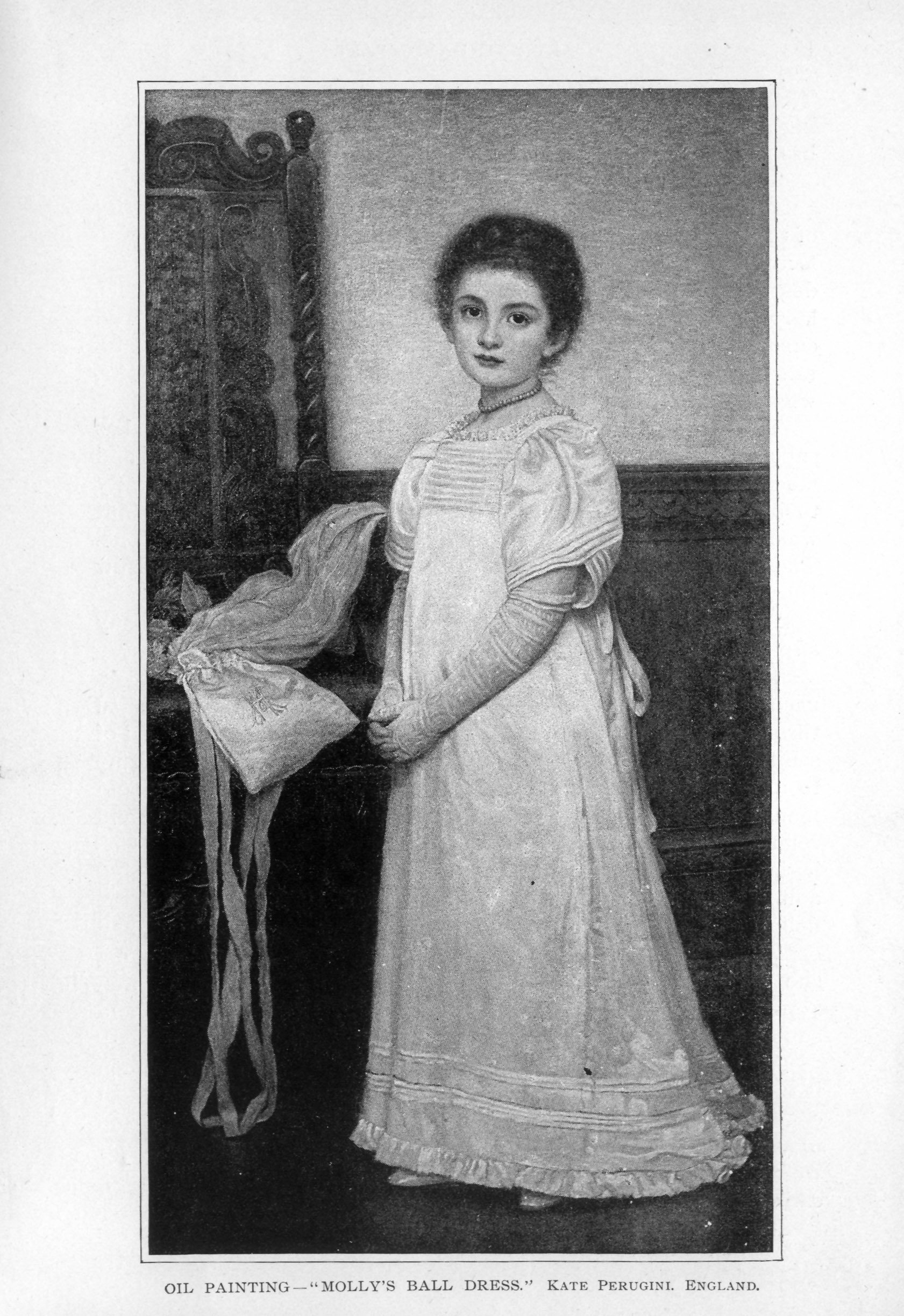
OIL PAINTING—
"MOLLY'S BALL DRESS."
KATE PERUGINI.
ENGLAND.
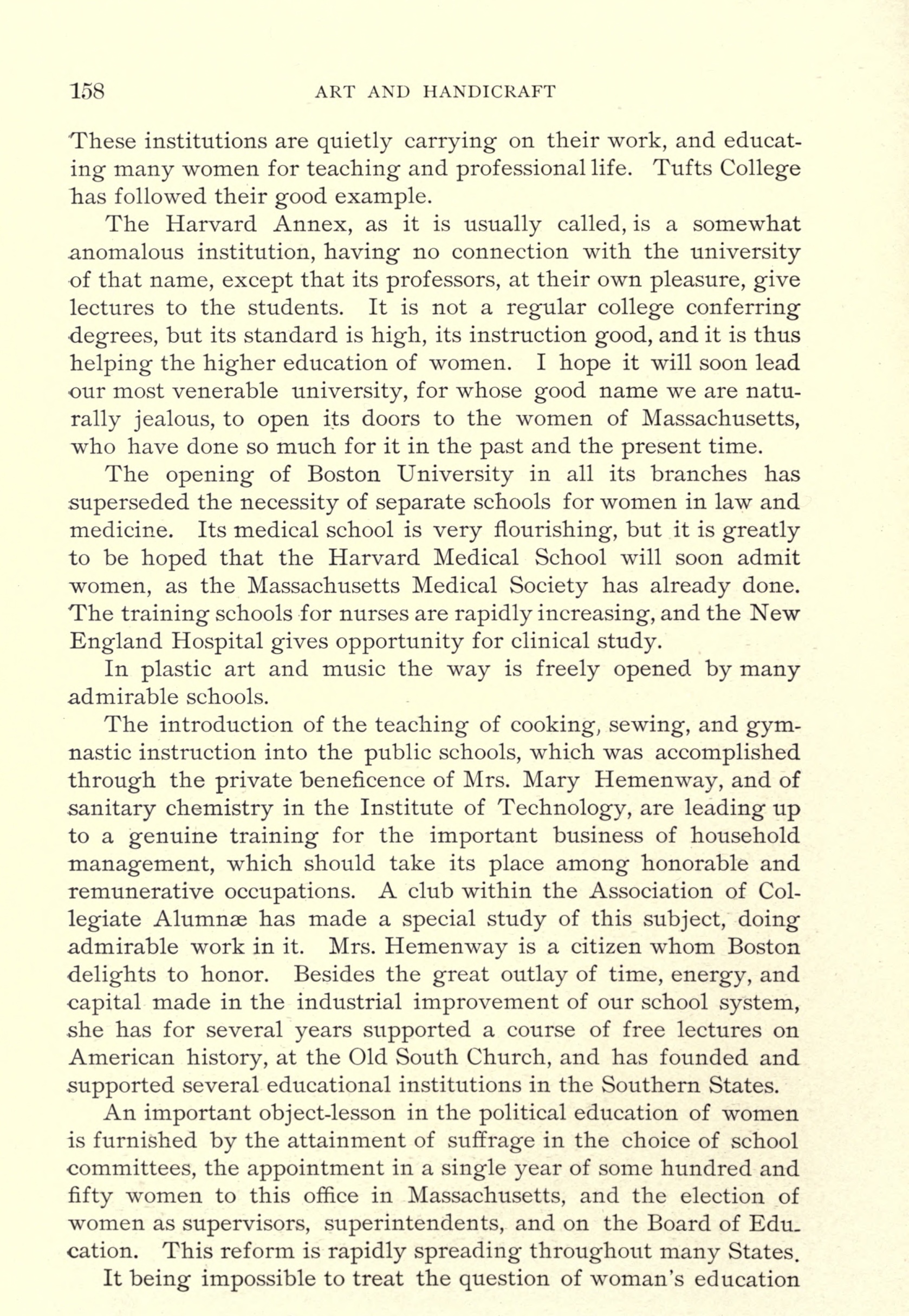
These institutions are quietly carrying on their work, and educating many women for teaching and professional life. Tufts College has followed their good example.
The Harvard Annex, as it is usually called, is a somewhat anomalous institution, having no connection with the university of that name, except that its professors, at their own pleasure, give lectures to the students. It is not a regular college conferring degrees, but its standard is high, its instruction good, and it is thus helping the higher education of women. I hope it will soon lead our most venerable university, for whose good name we are naturally jealous, to open its doors to the women of Massachusetts, who have done so much for it in the past and the present time.
The opening of Boston University in all its branches has superseded the necessity of separate schools for women in law and medicine. Its medical school is very flourishing, but it is greatly to be hoped that the Harvard Medical School will soon admit women, as the Massachusetts Medical Society has already done. The training schools for nurses are rapidly increasing, and the New England Hospital gives opportunity for clinical study.
In plastic art and music the way is freely opened by many admirable schools.
The introduction of the teaching of cooking, sewing, and gymnastic instruction into the public schools, which was accomplished through the private beneficence of Mrs. Mary Hemenway, and of sanitary chemistry in the Institute of Technology, are leading up to a genuine training for the important business of household management, which should take its place among honorable and remunerative occupations. A club within the Association of Collegiate Alumnæ has made a special study of this subject, doing admirable work in it. Mrs. Hemenway is a citizen whom Boston delights to honor. Besides the great outlay of time, energy, and capital made in the industrial improvement of our school system, she has for several years supported a course of free lectures on American history, at the Old South Church, and has founded and supported several educational institutions in the Southern States.
An important object-lesson in the political education of women is furnished by the attainment of suffrage in the choice of school committees, the appointment in a single year of some hundred and fifty women to this office in Massachusetts, and the election of women as supervisors, superintendents, and on the Board of Education. This reform is rapidly spreading throughout many States.
It being impossible to treat the question of woman's education
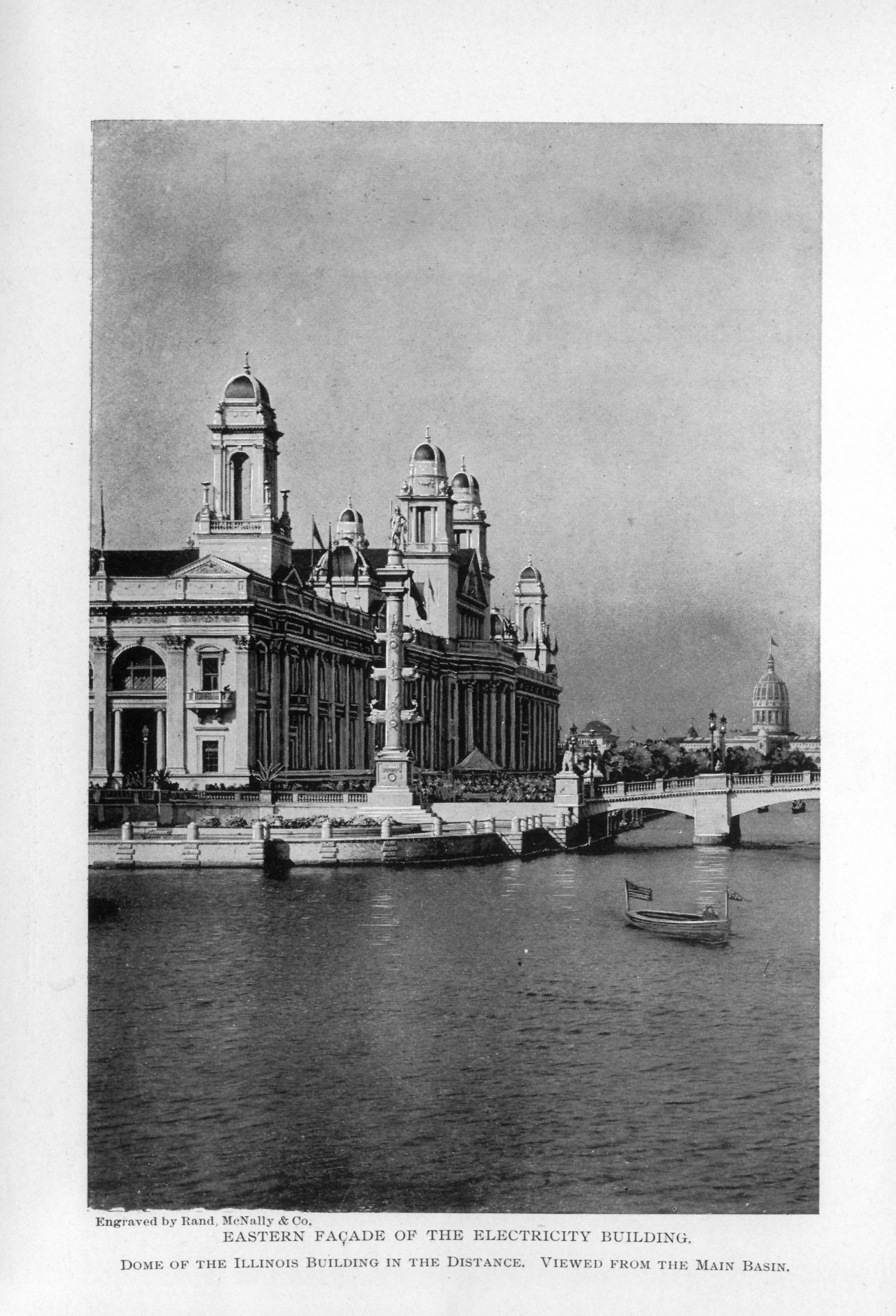
Engraved by Rand, McNally & Co.
EASTERN FAÇADE OF THE ELECTRICITY BUILDING.
DOME OF THE ILLINOIS BUILDING IN THE DISTANCE. VIEWED FROM THE MAIN BASIN.
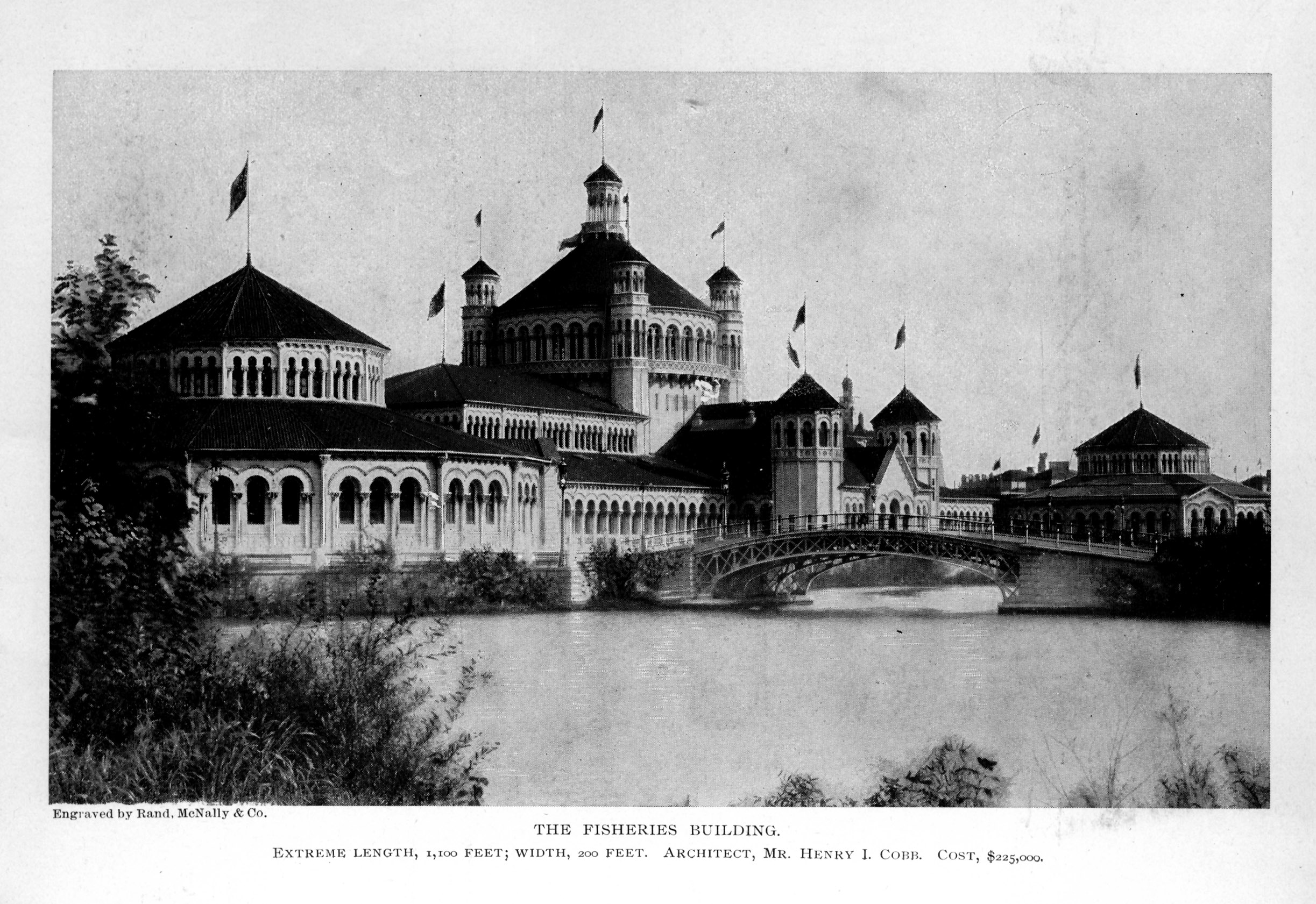
Engraved by Rand, McNally & Co.
THE FISHERIES BUILDING.
EXTREME LENGTH, 1,100 FEET; WIDTH, 200 FEET. ARCHITECT, MR. HENRY L. COBB. COST, $225,000.

throughout the country in the brief space allowed, I have given the story of its development in Massachusetts as enabling me to present it in a more clear and connected form, and also because the roots of the whole system were planted in this colony, which was more truly representative of the future America perhaps than any other.
But the march of education, as of empire, "westward takes it way," and since the opening of the great regions west of the Alleghanies to settlement, the school-house and the school-book—normal school, college, kindergarten, and training school—have gone with the emigrants over the mountains, and like the plants of other climes found congenial soil and grown more vigorously, but they have left behind them many enemies and parasites that checked their growth in their native regions. Especially has the education of women thus prospered. Co-education of the sexes has found less prejudice to contend with in the West than in the East. The noble stand taken by the University of Michigan, founded in 1837, in opening its doors freely to women, instead of hindering its prosperity, has helped to place it among the four oldest and best colleges of the country in rank.
Yale College, in Connecticut, one of the most conservative institutions in the country, has lately taken the last step first and invited women to her post-graduate courses. So many other institutions have fallen into this line of progress, that now it has been said by a superintendent of education that "a college course is looked upon as the rational and proper method of fitting a girl to do her share in the work of the world."
To carry out this last idea, the alumnæ of colleges admitting women have formed an association throughout the country to promote education. It numbers 1,458 members, of whom 175 have received master's or doctor's degrees, and 31 fellowship; 55 of the members are married women. They have done much to promote many practical measures, and have formed a bureau for the employment of teachers, which has led to a demand for college training for the teachers of all higher schools. It is significant, however, that while the highest salary for a non-resident teacher has been only $1,400, "the best situation has been offered by an insurance company for a private secretary of high attainments in stenography and higher mathematics."
The normal school system has also been extended over the whole Union. There are some twenty-three thousand pupils in the schools of thirty-eight States, and 71 per cent of them are women.
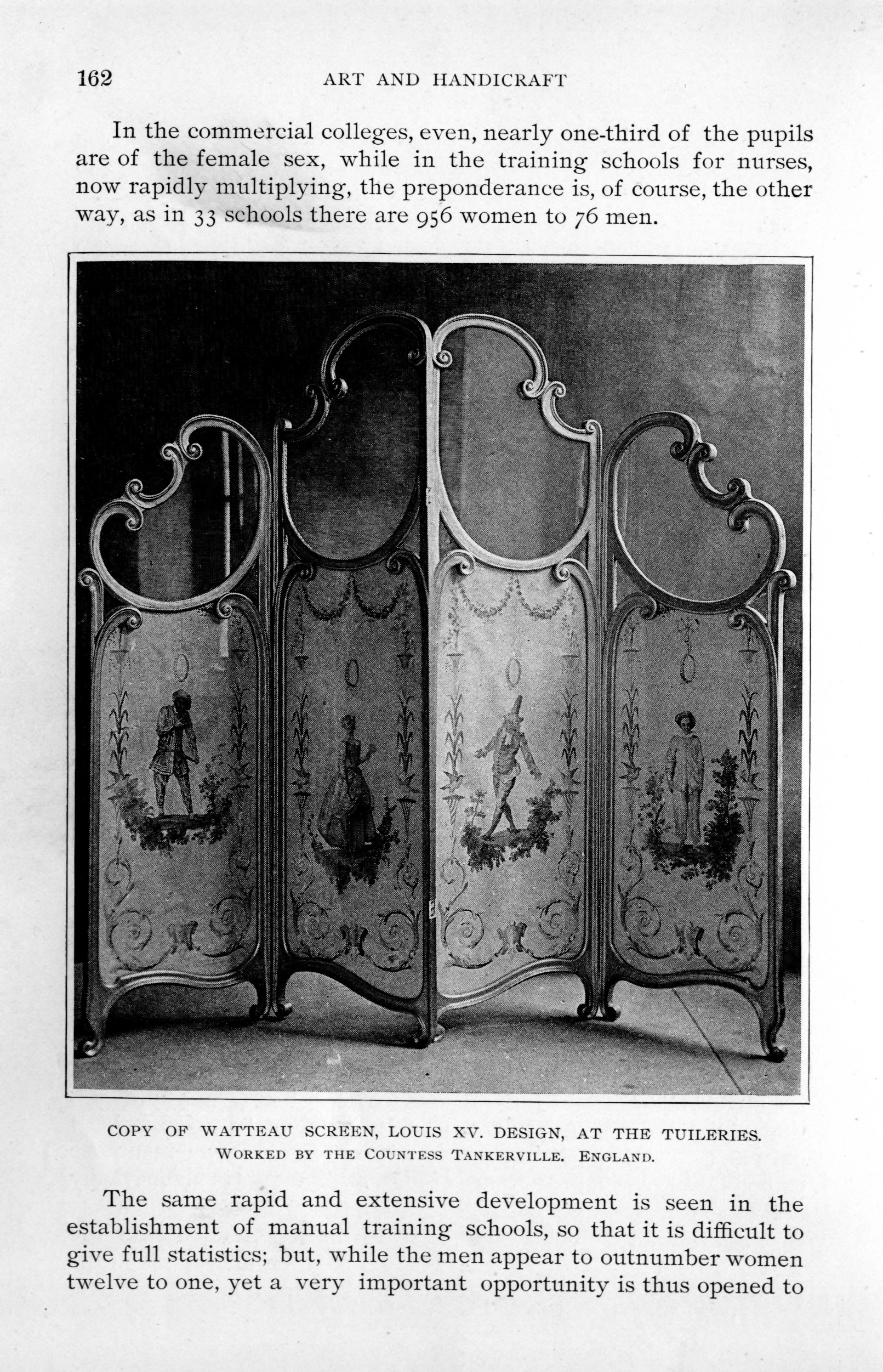
COPY OF WATTEAU SCREEN, LOUIS XV. DESIGN, AT THE TUILERIES.
WORKED BY THE COUNTESS TANKERVILLE. ENGLAND.
In the commercial colleges, even, nearly one-third of the pupils are of the female sex, while in the training schools for nurses, now rapidly multiplying, the preponderance is, of course, the other way, as in 33 schools there are 956 women to 76 men.
The same rapid and extensive development is seen in the establishment of manual training schools, so that it is difficult to give full statistics; but, while the men appear to outnumber women twelve to one, yet a very important opportunity is thus opened to
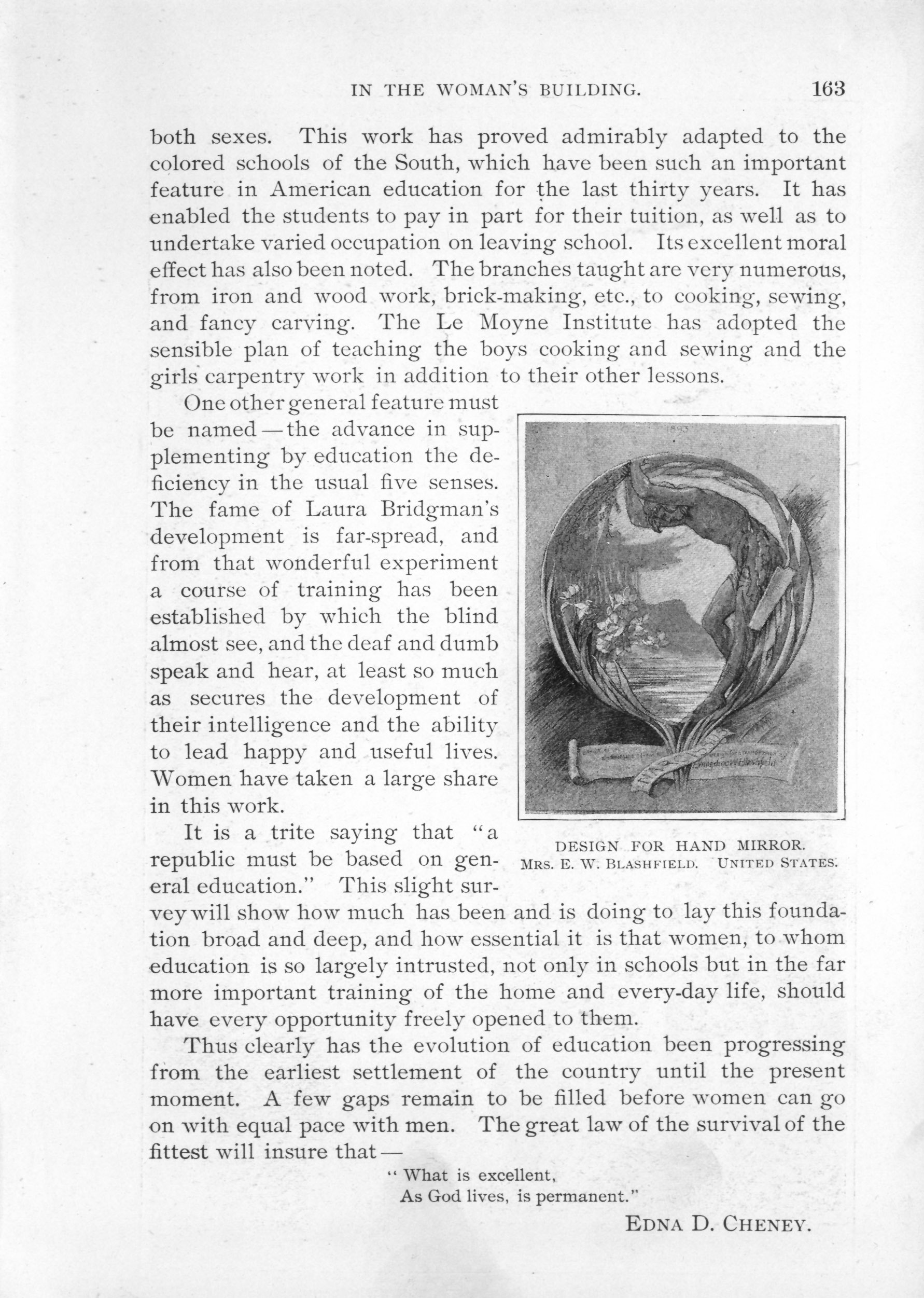
DESIGN FOR HAND MIRROR.
MRS. E. W. BLASHFIELD.
UNITED STATES.
both sexes. This work has proved admirably adapted to the colored schools of the South, which have been such an important feature in American education for the last thirty years. It has enabled the students to pay in part for their tuition, as well as to undertake varied occupation on leaving school. Its excellent moral effect has also been noted. The branches taught are very numerous, from iron and wood work, brick-making, etc., to cooking, sewing, and fancy carving. The Le Moyne Institute has adopted the sensible plan of teaching the boys cooking and sewing and the girls carpentry work in addition to their other lessons.
One other general feature must be named—the advance in supplementing by education the deficiency in the usual five senses. The fame of Laura Bridgman's development is far-spread, and from that wonderful experiment a course of training has been established by which the blind almost see, and the deaf and dumb speak and hear, at least so much as secures the development of their intelligence and the ability to lead happy and useful lives. Women have taken a large share in this work.
It is a trite saying that "a republic must be based on general education." This slight survey will show how much has been and is doing to lay this foundation broad and deep, and how essential it is that women, to whom education is so largely intrusted, not only in schools but in the far more important training of the home and every-day life, should have every opportunity freely opened to them.
Thus clearly has the evolution of education been progressing from the earliest settlement of the country until the present moment. A few gaps remain to be filled before women can go on with equal pace with men. The great law of the survival of the fittest will insure that—
|
"What is excellent, As God lives, is permanent." |
EDNA D. CHENEY.